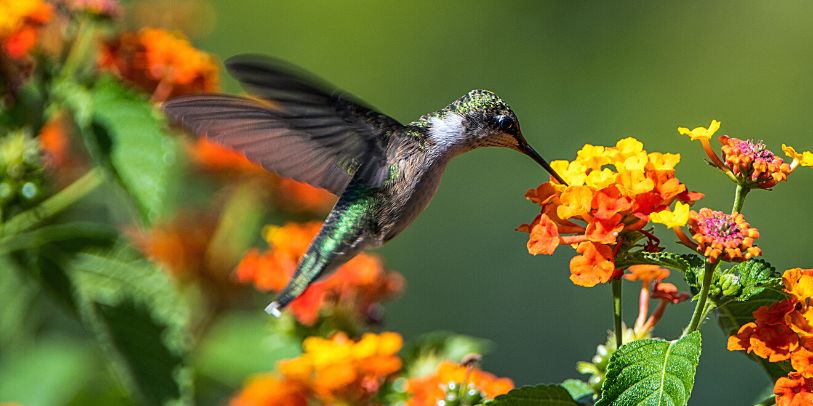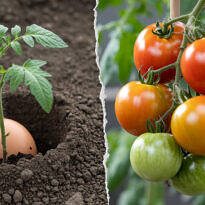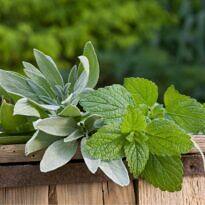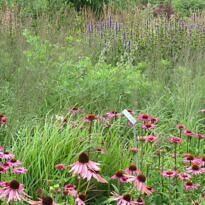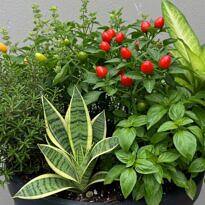I believe that the most delightful time when renovating or creating a garden is the moment of planting flowers! They are colorful, vibrant, and fragrant, and they make your garden enchanting. After arranging flowerpots or flower beds, our garden truly comes to life. I don’t know about you, but I spend hours admiring the blooming flower beds, taking photographs, and simply enjoying the pure beauty.
Beyond the visual impact, they also bring the bonus of attracting cheerful birds and butterflies that come to enjoy the nectar they offer. It’s a true daytime celebration under the sun, warming our hearts and bringing satisfaction to any dedicated gardener.
But before planting, we need to choose which beauties will grace our garden. I enjoy creating mixed flower beds, with perennial plants that bloom year after year, and annual plants of the season that bring color and renewal. Once we know the plants we’re going to use, we can play around with combinations of colors, shapes, and textures to create a truly stunning garden that catches everyone’s attention.
In addition to choosing between perennial and annual plants, we need to consider which ones best fit our region and the season of the year. Nurseries and garden centers can help with this aspect and often offer season-appropriate plants in ready-to-plant trays. All that’s left for us to do is choose the most beautiful ones in our eyes. However, we must remember that a garden’s life isn’t solely about beauty.
We should also consider the most resilient and durable plants so that when we place them in our flower beds, they remain beautiful for as long as possible, and we don’t engage in endless battles against persistent pests and diseases. It’s interesting to think that native plants from our region are the ones that will adapt best to our garden, with the least possible challenges. They’re already accustomed to the climate and soil and require minimal care.
For an even more distinctive and innovative garden, don’t limit yourself to what’s available at the nursery. Invest in varieties and cultivars that grow from seeds. Apart from being more economical, seeds offer a much wider range of possibilities for your garden. The flower beds that have the most success in my garden are always the ones I plant from seeds. People often ask me where I bought those plants, what species they are, and how they can get them. I proudly tell them that I planted them myself.
Now, let’s get to our list of 40 flowering plants that love full sun for the most colorful flower beds:
1. Amaryllis – Hippeastrum hybridum
Known as the “Brazilian tulip,” amaryllis is the type of noble flower that truly catches the eye. With an upright and elegant stature, this beautiful flower is native to Brazil. It has been improved by the Dutch, who created various cultivars of the plant with white, pink, red, and variegated flowers that can be single and large or resemble lovely bouquets. Amaryllis hides its bulbs underground, and we can create flower beds under full sun or partial shade that become even more beautiful year after year. Beware of caterpillars and borers that can nibble on the leaves and bulbs, sometimes remaining hidden enemies.
2. Calibrachoa – Calibrachoa x hybrida
With dense and well-branched foliage, calibrachoa is a close relative of petunias. With abundant flowering in various colors and single or double flowers, it brightens up any garden. It’s a sight to behold when planted directly in flower beds and simply stunning when in hanging baskets and planters. But be warned, this little flower loves the sun—don’t attempt to grow it in shaded areas. It requires around 4 to 6 hours of sunlight per day, in other words, full sun all day long.
3. Daylily – Hemerocallis x hybrida
Daylily seedlings are a bit pricier than other tray flowers. That’s because investing in this beauty is worthwhile. As a perennial plant, it doesn’t die at the end of the season, and the flower beds become fuller and more beautiful with each passing year. Pruning at the end of summer and the beginning of autumn is important to prevent rust. Keep the flower beds well-fertilized with good-quality NPK and organic compost.
4. Wedelia – Sphagneticola trilobata
A small yellow and rustic daisy, native to the Brazilian coast. Very versatile, wedelia thrives in any garden, even in vertical gardens. Maintenance is quite simple, requiring occasional pruning to renew foliage and regular fertilization. Moreover, propagating this plant is extremely easy. Simply make small cuttings and plant them on moist substrate. They’ll quickly root and be ready to transplant into flower beds.
5. Bulbine – Bulbine frutescens
This succulent resembles a chive. With light green leaves, bulbine blooms continuously throughout the year and is quite hardy. There’s a variety with yellow flowers and another with orange-yellow flowers. Used as ground cover, it’s a true survivor. It thrives in areas with low water availability and even works for green roofs. Over time, it forms a dense mat. However, don’t step on it. To care for this delicate flower, it’s important to remove old flower stalks and replant it every two or three years to maintain its beauty and vigor.
6. Ice Plant – Lampranthus productus
Perfect for coastal gardens, this succulent can even grow in dunes. It’s also great for rocky gardens, where you can plant it in the gaps between stairs and stones. There are now cultivars with flowers in various colors beyond pink, including red, orange, yellow, and white. It requires little irrigation and fertility and can be planted as ground cover or a mass of flowers, as well as in pots and hanging planters where it acts as a trailing plant.
7. Society Garlic – Tulbaghia violacea
Some people dislike society garlic due to its pungent garlic aroma, even when it’s not flowering. Despite not being a fan of the smell, I like this species because it’s hardy and has delicate blooms. I use it sparingly in my garden, so the smell isn’t overpowering. This bulbous plant is also considered an edible plant with unconventional uses, and its leaves and bulbs can be used as a substitute for garlic.
8. Globe Amaranth – Gomphrena globosa
Globe amaranth, also known as purple amaranth, can be used as ground cover or in mass plantings. Its delicate white, pink, red, or purple flowers have a whimsical effect, resembling small and fluffy pompoms. Additionally, we can harvest and dry the flowers for use in everlasting arrangements. It behaves like an annual and should have flower beds renewed each spring. Purchase seedlings at the garden center or sow them in trays.
9. Yellow Shrimp Plant – Pachystachys lutea
Moving away from ground-hugging plants, we have this beautiful shrub-like shrimp plant. With golden yellow inflorescences against a backdrop of green leaves, it stands out during flowering. The true flowers are small and tubular and irresistible to hummingbirds. Due to its larger size, it’s best to plant it at the back of lower-growing plants so they complement each other and don’t obstruct the view.
10. Kalanchoe – Kalanchoe blossfeldiana
I believe almost everyone knows Kalanchoe. Its vibrant colors are enchanting, making it the most popular succulent. Apart from the various colors, there are also cultivars with double flowers, known as “calandivas.” What many people don’t know is that we can plant it in the garden to create colorful flower beds in full sun. Fertilize with NPK and avoid areas prone to waterlogging, as the plant is sensitive. Whenever possible, remove old flowers to encourage new blooms.
11. Lupine – Lupinus hybridus
Native to North America, lupines look like little breaths of fresh air in the garden. Tall inflorescences speckled with flowers of various colors create the feeling of being in a Monet painting. There are both shorter and taller cultivars, reaching heights of up to 1.5 meters (5 feet). Despite its charm and beauty, lupines aren’t very popular in Brazil due to their preference for subtropical and temperate climates, better suited for mountainous and southern regions of the country. They can be propagated from seeds.
12. Lantana – Lantana camara
A Brazilian beauty that catches the eye. Lantana is a shrub that naturally produces these gradient inflorescences, transitioning from yellow to orange, pink, or red. There are also varieties with entirely purple, white, or yellow flowers. Such beauty is irresistible to us and butterflies, which eagerly collect nectar from its flowers. Always plant it in full sun.
13. Freesia – Freesia x hybrida
Hailing from South Africa, the mesmerizing freesias are now a rare sight, except in well-tended gardens of devoted gardeners. These bulbous wonders showcase a kaleidoscope of colors, blending whites, yellows, reds, pinks, oranges, and purples. Their petite size keeps them discreet throughout the year, only to burst forth with exquisite winter blooms that seem almost unreal. Thriving in subtropical climates, freesias are a true gem.
14. Bicolor Moraea – Dietes bicolor
Bicolor Moraea is the darling of modern gardens. Its rustic, green clumps effortlessly fill borders and beds, requiring minimal maintenance. Remarkably, it blooms year-round, adorning itself with delicate cream-yellow flowers marked by ebony accents. Despite its omnipresence, Bicolor Moraea remains a personal favorite, especially when used to embellish sidewalks, walls, fences, and edges, serving as a virtually vandal-proof adornment.
15. China Pink – Dianthus chinensis
Hailing from Asia, the China Pink has enchanted Brazilian gardens. Its delicate, fringed blossoms in vivid colors form dense masses under the sun or partial shade. These colorful patches, resembling a carpet on small garden hills, contrast beautifully against well-maintained lawns. China Pinks are pure poetry, impossible not to admire. You can grow them from seeds or acquire them at your local garden center.
16. Blanket Flower – Gaillardia x grandiflora
Why not infuse your garden with the grace and warmth of sunflowers, but in a more compact form? Blanket Flowers, also known as Spanish Blankets, offer just that. Many enthusiasts struggle to cultivate standard sunflowers, which tend to grow too tall and cumbersome, disrupting the aesthetics of garden beds. Blanket Flowers elegantly solve this problem, bringing a blaze of fiery shades between yellow and red to your garden. Propagation through seeds is a breeze.
17. Chinese Ixora – Ixora chinensis
The Chinese Ixora, with its stunning bouquets of pink, yellow, orange, or red, originates from Asia. Despite its origin, it has become a favorite in Brazilian gardens, and some even mistake it for a native species due to its popularity. However, its beauty truly shines in tropical gardens, as it thrives in sunlight and warmth. This shrub can reach up to 2 meters in height but can also be used in mass plantings or as a hedge if regularly pruned. Keep the beds well-fertilized and monitor for pests to ensure it enjoys a long life and blooms all year round.
18. Dark Coreopsis – Coreopsis tinctoria
Imagine a flower that brings the essence of the countryside to your garden. The charming dark coreopsis fits the bill perfectly. With slender stems and leaves adorned with numerous yellow flowers and brown centers, it pairs beautifully with other species that offer a rustic vibe, such as Baby’s Breath or Gladioli. This annual plant self-seeds and blooms year after year in the same spot, even spreading throughout the neighborhood.
19. Daisy – Leucanthemum vulgare
A true classic that requires minimal maintenance, daisies are perennial plants that form low clumps of dark green foliage, adorned with large white flowers and yellow centers. They’re perfect for mass plantings, borders, and containers, and can be propagated by dividing the clumps, which widen over the years. Keep the beds well-fertilized to enjoy abundant blooms and healthy plants.
20. Snapdragon – Antirrhinum majus
Snapdragons are incredibly versatile and thrive in beds, containers, and cut flowers. Different cultivars are suitable for various purposes. Bed plants are petite, delicate, and offer continuous blooming, while those meant for cutting are tall and exuberant, boasting sturdy floral stems and long-lasting flowers. Available in a wide range of colors, these snapdragons relish cooler temperatures and are considered winter annuals.
21. Vinca – Catharanthus roseus
Vinca is a cosmopolitan species found on all continents. It thrives even where it’s not invited and stands out wherever it takes root. This ever-blooming plant sports one or more flowers in the axils of its leaves, with colors ranging from white to pink, lavender, and even red. It’s perfect for creating colorful spots amidst greenery, especially in rock gardens.
22. Gazania – Gazania spp.
Native to Africa, gazanias are known for their daisy-like flowers with vibrant shades of yellow, orange, and red. These low-growing plants are perfect for sunny borders, rock gardens, or containers. They’re drought-tolerant and thrive in hot conditions, making them an excellent choice for gardens with lots of sun. Gazanias close their flowers at night and on cloudy days, adding a touch of interactivity to your garden.
23. Alyssum – Lobularia maritima
Alyssum, also known as sweet alyssum, is a low-growing, dense, and floriferous plant. Its compact form makes it an excellent choice for foreground planting, whether in garden beds, pots, planters, or hanging baskets. To enjoy its delicate, numerous white flowers, make sure to provide plenty of sunlight. You can also find varieties with yellow, orange, purple, pink, and red flowers. The sweet honey fragrance of this plant is an irresistible attraction.
24. Verbena – Verbena hybrida
Also known as vervain, verbena is a native biennial plant that stands out with its vibrant and intense colors. It thrives in well-draining soil and can even flourish in coastal areas where it often grows spontaneously. With selections and improvements, you can now find verbena in shades of white, red, lilac, deep purple, wine, and variations with white centers. This plant is easily propagated from seeds.
25. Marigold – Tagetes erecta
If you’re seeking to add shades of gold, cream, lemon yellow, or vibrant orange to your garden, marigolds are the answer. These large pompom-like flowers are available in various shades between yellow and orange. They’re perfect companions for other plants in your garden, as marigolds release substances that repel pests like insects and nematodes. This makes them ideal for protecting your vegetables as well. Despite some not liking their scent, their undeniable beauty and utility make them a valuable addition to any garden.
26. Calendula – Calendula officinalis
Calendula, also known as pot marigold, is a versatile flower with both ornamental and medicinal value. Its large orange flowers resemble daisies and have potent healing properties. These flowers can be used to make teas, tinctures, ointments, and poultices, offering qualities such as wound healing, anti-inflammatory effects, and antiseptic properties. Calendula is an annual plant, so it’s recommended to renew your garden beds when the plants decline. It’s easily propagated from seeds and readily available in garden centers.
27. Zinnia – Zinnia elegans
Do you long for vintage-like colors that exude timeless charm? Zinnias are the answer. Available in hues ranging from rose, yellow, and red to white, purple, and orange, these flowers also come in captivating striped and bicolored varieties. Thriving in the tropical heat and sunlight, zinnias grow across the country, even enduring milder climates. These summer annuals are a breeze to plant from large seeds, resembling sunflower seeds. Take care during planting, though, as birds might snatch the seeds before they sprout.
28. Plumed Celosia – Celosia argentea
Step back into your grandmother’s garden with the enchanting plumed celosia. Its elongated, feathery inflorescences resemble soft peaks of meringue. These flowers dazzle in shades of cream, yellow, orange, pink, red, and purple. Adding to their allure, their light green foliage illuminates any garden. Embrace a whimsical and nostalgic ambiance with these fantasy-like blooms gracing your flowerbeds.
29. Twinspurs – Diascia spp
Think of the word “twinspurs.” What comes to mind? Perhaps festivities and carnival? These delicate, petite flowers evoke exactly that feeling. With their charming and small blossoms, they resemble a cascade of colorful confetti. While they adore the sun, they’re not as keen on intense heat, favoring milder climates in the south and southeast. As summer annuals, they’re best planted towards the end of winter to provide a festive display from spring through summer and into autumn.
30. ‘Sunpatiens’ Impatiens – Impatiens hybrida
Traditionally, most impatiens flowers shy away from direct sunlight, withering under its intensity. Yet, ‘Sunpatiens’ has emerged as a prolific, robust hybrid of Impatiens hawkeri, thriving under both rain and intense sun. With this hybrid, the colorful kiss-painted blooms can now flourish in sunny spots, gracing your garden with mass plantings, borders, and hanging baskets. Obtain your ‘Sunpatiens’ from your local florist.
31. Angelonia – Angelonia angustifolia
Imagine a garden fragrance reminiscent of grapes or apples. Enter the delightful scent of angelonia, a delicate-looking plant with tall, erect inflorescences adorned with white, pink, purple, blue, or salmon-colored blossoms. These blooms grace your garden in spring and summer, adding a touch of elegance. You can find these beauties at the finest garden centers, where they propagate readily.
32. Purslane – Portulaca grandiflora
Prepare to be captivated! Purslanes are succulent, ground-hugging plants boasting large, vividly colored blossoms. While florists predominantly offer pink, white, and variegated options, sowing these flowers from seeds can yield an even more diverse palette, including yellow, red, and orange in various patterns, from solid to variegated. The flowers can be simple, with a single row of petals, or double, with multiple layers. Avoid overly damp areas for planting, and if needed, slightly elevate the beds for improved drainage.
33. Wax Begonia – Begonia semperflorens
Unlike most begonia species that prefer shade, the wax begonia thrives in full sun. Its vibrant flowers come in white, pink, or red hues, accompanied by lush green or bronzed foliage. Notably, its tangy edible flowers add a unique flavor to your garden. Although technically perennials, they’re best treated as annuals since their beauty wanes over time. Easy to propagate through seeds or cuttings, wax begonias are readily available at Garden Centers.
34. Garden Sage – Salvia splendens
Also known as scarlet sage, these vibrant flowers are a visual treat, available in an array of colors beyond red. Thriving in well-fertilized soil and ample sunlight, these easy-to-cultivate flowers can grace gardens from north to south. Whether you opt for seed trays or seeds themselves, you can find them at local nurseries or garden centers.
35. Lily of the Nile – Agapanthus africanus
The enchanting agapanthus, often dubbed “African lily” or “Lily of the Nile,” is anything but ordinary. With its captivating blue hue and dark green tufted foliage, it remains stunning year-round. Pairing beautifully with yellow flowers, agapanthus makes for a striking contrast. To maintain their allure, divide and enrich your flower beds every four years.
36. Everblooming Petunia – Petunia integrifolia
Native to South America, petunias have gained international popularity due to their varied patterns and colors. From classic white and pink to bold blue, red, and even multicolored options, these annual flowers thrive in hanging baskets and well-fertilized beds. Beware of caterpillars and opt for a mild climate; you can find these flowers at your local Garden Center.
37. Pansy – Viola x wittrockiana
Exquisite pansies charm with their delicate appearance, resembling tiny faces among organized leaves. These annual winter bloomers flourish as a mass planting or in pots. Perfect for cooler subtropical climates, these flowers are available in various shades. Embrace their beauty by planting in autumn, and explore unique cultivars through seeds for a mesmerizing display.
38. Wishbone Flower – Torenia fournieri
Known as wishbone flowers or summer pansies, torenias offer velvety trumpet-shaped blooms in shades of blue with white or yellow throats. These versatile annuals come in various sizes, from compact to trailing. With a rich palette beyond blue, including white, pink, yellow, purple, and red, summer pansies thrive in sunny spots.
39. Purslane – Portulaca oleracea
Often confused with the common purslane, these edible and medicinal plants offer distinct features. With small, simple flowers and broad leaves, purslanes are the new trend for beds and pots. Opt for well-draining containers to prevent excess moisture. Explore the success of the mesmerizing variegated cultivars.
40. Cape Jewelflower – Nemesia strumosa
Wrapping up our list, allow me to introduce you to the Cape Jewelflower. Much like snapdragons, these delicate little blossoms create stunning masses, borders, and beds that will leave you in awe. They come in a variety of colors, blends, and gradients, with unique combinations between the upper and lower petals. Hailing from South Africa, they adore sunlight but can’t withstand droughts, frost, or intense heat (above 29°C).
Phew! Our list of sun-loving plants concludes. I hope you’ve selected your favorites for your Garden Center shopping spree. Remember to fertilize the plants for even more intense and enduring blooms. Here’s a vital tip: Perform pinching (trimming of the top shoots) on the plants during their growth. This simple pruning during their development is crucial to encourage denser branching, resulting in lush flower beds and plants that spread outwards more than upwards.
Happy planting!


